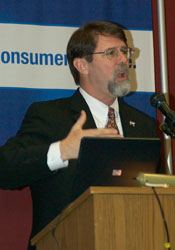
Issues Forum: Nutrition
Experts provide analysis and discuss ramifications to the beef industry of the new Dietary Guidelines for Americans 2005.
 |
| Eric Hentges, executive director for the U.S. Department of Agriculture (USDA) Center for Nutrition Policy and Promotion. |
Issues Forum: Nutrition
New nutrition guidelines label coming soon.
SAN ANTONIO, TEXAS (Feb. 5, 2005) — American consumers should expect more information soon about what they are purchasing and eating. In the next year, food packages will more prominently display information such as calories per serving, serving size, transfatty acid content and how the food fits into dietary guidelines put forth by the U.S. Department of Agriculture (USDA). Bill Layden, executive vice president and U.S. director of food and nutrition practice with Edelman Public Relations, told attendees of a Beef Industry Issues Forum that consumers should expect other nutrition-related changes as well. The nutrition forum was held Thursday, Feb. 3, at the Cattle Industry Annual Convention and Trade Show in San Antonio.
Layden said government regulators are currently looking at creating new laws to govern marketing and advertising directed at children, and increased legal accountability for food manufacturers and providers for what America eats.
Changes to Americans dietary landscape are a direct result of an increased focus on the waistline. Two-thirds of Americans are overweight or obese, said Eric Hentges, executive director, USDA Center for Nutrition Policy and Promotion. USDA is taking steps to help consumers regain control of their diets and achieve a healthier lifestyle, he said.
USDA unveiled the new 2005 Dietary Guidelines for Americans Jan. 12. The guidelines, 13 months in the making, will serve as a nutrition roadmap for policymakers, healthcare providers and nutrition educators. “The plan was developed through a scientific, evidence-based approach,” Hentges said. He believes the government will continue to use the same type of scientific approach in the future, and he counseled any food and nutrition lobbyists to be prepared with background evidence.
Hentges said the next step is to finalize and unveil the consumer outreach component of the Dietary Guidelines. He added that consumers will receive eating and exercise guidance through visual diagrams and brochures, as well as through interactive online resources.
The Dietary Guidelines cover nine topic areas, and include basic, commonsense advice such as:
• Eat a variety of whole fruits in any form, while limiting fruit juice.
• Eat more dark green and orange vegetables, beans and peas.
• Get adequate calcium by consuming at least three cups of low-fat or fat-free dairy per day.
• At least half your grains [3 ounces (oz.) per day] should be whole grains.
• Choose a variety of lean meats, poultry and other protein sources,
• Monitor and moderate intake of fats, salt and sugar.
• If consuming alcohol, do so in moderation.
• Practice safe food handling and preparation.
Hentges stressed that a central theme of the Dietary Guidelines is to “get the most nutrition out of your calories” or eat more naturally nutrient-rich foods, such as lean beef. The 2005 guidelines also emphasize the need to get regular physical exercise and to balance caloric intake with energy expended through physical activity.
Susan Borra, registered dietitian, executive vice president, International Food Informational Council Foundation, said that consumers respond better to “do messages” rather than “don’t messages.” The Guidelines were written with this in mind.
Americans often say their greatest barriers to healthy lifestyles are feeling too busy or believing that healthy eating and exercise are too difficult or too expensive. Conversely, motivating factors are the desire for a healthy lifestyle and better quality of life, as well as looking good and being a good role model for their children.
“The beef industry needs to continue to communicate the positive benefits of eating beef,” Borra said. “The industry should lead with science, listen to consumers and build powerful partnerships with other organizations.”
Patti Buck, a cattle producer and American National CattleWomen member from Durango, Colo., who attended the session said that she was going to take the information back to her state.
“Cattle producers are always trying to educate youth and counteract other groups that are more vocal than we are,” Buck said. She has participated in classroom education efforts to reach youth, but said that the beef industry needs to focus on the parents as well.
The Nutrition Issues Forum was funded by a grant from Pfizer Animal Health. For more information, visit www.healthierus.gov.
Editor’s Note: This release is adapted from a news release distributed by the NCBA. For the original release, click the “News & Resources” link at www.beefusa.org.